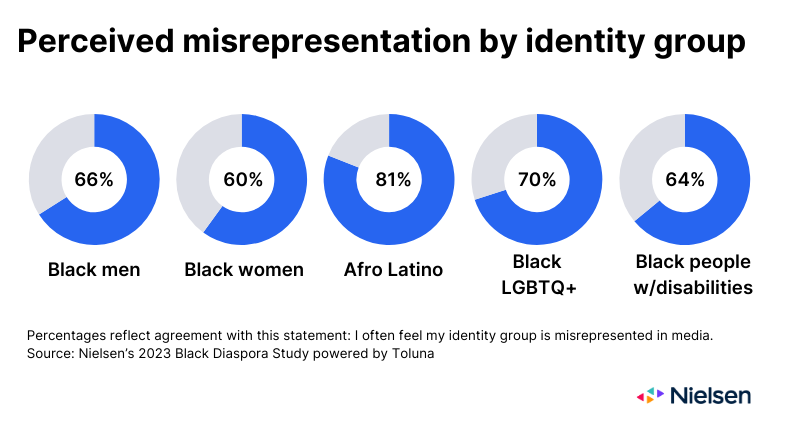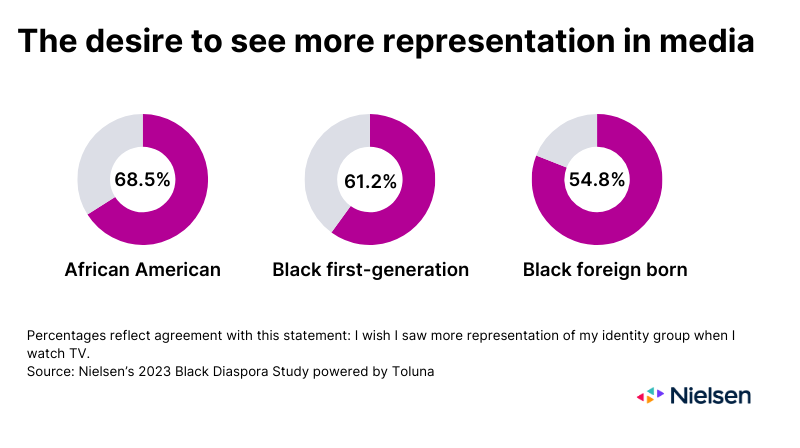Representation and inclusion remain critical for the global media industry, and examples of progress continue to break through. At the 81st Golden Globe Awards, for example, first-time nominees Da’Vine Joy Randolph, Ali Wong, Steven Yeun, Lily Gladstone and Ayo Edebiri took home awards for their performance achievements in TV and film. Select examples aside, however, Black audiences in particular continue to want more—especially when it comes to portrayals of their communities that are authentic and nuanced.
While recent hits like Queen Charlotte, The Blackening and They Cloned Tyrone portrayed diverse friend groups, story lines and genres, many Black audiences view the portrayals of their identities as one-dimensional1. At least part of that sentiment stems from the perception that on-screen urban portrayals remain far more prevalent than rural and suburban portrayals.
But we know that authenticity involves more than character setting. Dimensions of diversity are numerous, spanning well beyond skin tone and narrative location. Seventy percent of Black audiences who identify as part of the LGBTQ+ community, for example, believe they are misrepresented in media, while 81% of Afro Latinos feel misrepresented1.

Dimensions of diversity will become even more important considerations in Black representation over time, as the U.S. Census forecasts that one-third of the Black population’s growth through 2060 will come from immigration, adding to the complexity of an already diverse audience. According to our recent Black Diaspora Study, powered by Toluna, an average of 47% of respondents from Brazil, Nigeria and South Africa say they wish they saw more of their identity group on TV.

From a content consumption perspective, the perceptions of representation among Black audiences are critical considerations for the media industry. That’s because they have considerably more media engagement than the general population. They also spend nearly 32% more time with TV each week than the general population2. The implications of this level of content engagement spans beyond creators and platforms. They are just as relevant for brands, especially as audiences continue increasing their time with ad-supported video content.
More than 35% of Black Americans believe brands portray all Black people the same in advertising
The right message is critical, and a persona-rich audience highlights the importance of understanding individuals within a diverse community. Our recent Black Diaspora Study found that brands have some ground to gain on this front. That’s because 35.7% of Black Americans believe that brands always represent Black people the same way in advertising, compared with 27.9% among the U.S. general population. The disconnect between how Black audiences feel they’re represented in a campaign could affect the ROI that brands are counting on to fuel growth.
We know that people want to see themselves in advertising, but audiences also want what they see to match what they see through their own eyes. Relevance is critical to engagement across all media types, and global audiences have different perspectives about which media types have the most relevant advertising. Black audiences in Nigeria, the U.K. and South Africa want more relevant ads in traditional and streaming TV content, while Black audiences in Brazil express the most desire for more relevant ads in streaming music.
Knowing that consumers often seek out brands that champion causes and messages they believe in, relevance, at least to many audiences, has come to represent more than just a brand promise. Relatable value propositions will always be critical, but Black consumers have come to expect that brands support the causes they care about. And when brands don’t measure up, the Black community—especially in Nigeria, the U.K. and Brazil—isn’t afraid to walk away from them.
At its core, media is a means of connecting. The stronger the connection, the greater the engagement. Through that lens, no audience places a higher level of importance on media than Black audiences do. To maintain the engagement of this media-hungry audience, inclusion should be at the forefront of each production’s and brand campaign’s growth and development strategy in this next era of media. In an increasingly fragmenting media world, discerning audiences will be quick to move on when they land on something they don’t like.
For additional insights, download our latest Black Diverse Intelligence Series report: The global Black audience: Shaping the future of media.
Notes
1Nielsen’s 2023 Black Diaspora Study powered by Toluna
2Nielsen National TV Panel; Q2 2023


